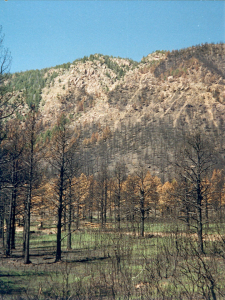Worth repeating: from the 2015 Mt Herman CWPP, a recounting of the Berry Fire:
21 April 1989; Turner Road,
Mount Herman Estates, Monument Colorado
The Berry Fire of 1989 is a perfect example of major risks which still threaten the Mount Herman Community and the Pike National Forest. The Berry Fire was human-caused. Whether it was arson or accident, it is indicative of a major threat. The fire started on private property at a location which offered the opportunistic conditions for a hidden campfire and under-aged drinking; a practice that has now transferred to locations all along Mt. Herman Road. In 1989 there were only three residences in Mount Herman Estates and the quiet west end of Turner Road was a relatively short distance from Monument, up reasonably maintained dirt roads. The fire that grew and spread north onto the Pike National Forest may have been intentional or it may have been an improperly extinguished campfire (such as the scores of fires that are lit and left burning every season up and down Mt. Herman Road).
Another major risk factor that contributed to this fire was fuel loading. It should be noted that wind was not a factor and high daytime temperatures preheating the fuels was also not a factor. It was April 21st, early spring, temperatures were mild, no new grasses would sprout for a month and the oak leafing out was still more than a month in the future.
The initial fire began to spread during a clear Friday morning. Smoke was noted and a Type 6 engine (brush truck) responded to the scene and small areas of flame were attacked by the crew, within the areas that they could reach near Turner Road. It was believed that they had taken the upper hand and that the small fire would be contained.
However, as the fire punked out to the north it entered huge areas of Gambel oak which had a forest floor of duff – oak leaves and grasses – which were now preheating from the noonday sun. The fire soon involved large stands of winter dried oak and took off. On a windless day this fire grew, in a stationary location, creating its own wind and starting to spread in all directions, fed by its own intensity. The vertical column of smoke rising past thirty thousand feet was clearly visible from downtown Denver. As the fire grew, one of its edges marched slowly back towards Turner Road.
The ten foot tall oak in its path fed a wall of flames fifty feet high. These flames, without wind driving them, were more than the Type 2 engines (now defending the two homes on Turner Road) could contend with and the decision was made to withdraw to safety. Both homes had been built without “defensible space” (a term completely outside the vocabulary of Colorado’s WUI residents of 1989).
The Berry Fire was only a few hours old, but now it was huge and the afternoon winds were starting to rise. Emergency responders understood the growing threat, and plans for evacuating Monument and Palmer Lake were being considered as word of this spread. Unencumbered by today’s bureaucratic barriers, Fort Carson jumped into the fray and sent two CH-47 Chinook helicopters equipped with drop buckets. They immediately started dipping from Monument Lake and hitting the eastern perimeter of the fire. The minor winds that were rising were initially coming out of the southwest and were slowly driving the fire in a counterclockwise path that was consuming more than one thousand acres of the Pike National Forest Monument Preserve and the east face of Mount Herman. One small benefit of these winds was that the fire changed its direction, within feet of the two homes on Turner Road, and the homes were saved by the engine crews. The fire was left to punk around in the oak and pine on the northern properties of Mount Herman Estates.
Now, in 2015, Red Flag days are a common year-round occurrence. But April 21st, 1989 had only one ingredient that goes into a Red Flag Day calculation; dry fuels. Yet, within a few hours a small fire had turned into an uncontrollable inferno that in retrospect was neither stopped nor mildly impacted by any human effort. The fire’s boundaries were almost completely defined by the wind and, in a sense, by the lack of wind. By late afternoon the small winds had died, the temperature was dropping while the humidity was rising, and the fire “laid down”. The next morning, slurry drops high on the slope of Mount Herman secured the western boundary of the Berry Fire.
The fire made the news for a few more days; it was an exciting local event – but not nearly as news worthy as the previous year’s Yellowstone Fire. And then Colorado forgot about it. But not all of us. Some of us lost our beautiful back yard and part of our dreams that day. Thousands of Coloradans lost a whole lot more to wildfires in the years since then.

The author of this depiction is Mark Schumann, a long-time Mt Herman resident. Edits by Steve Roscio and Diane Strohm.
Hearing this makes me wonder… what happened to the descendants of the Coyote Girl of Monument? I hope they were safe during the fire!